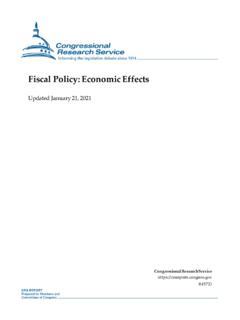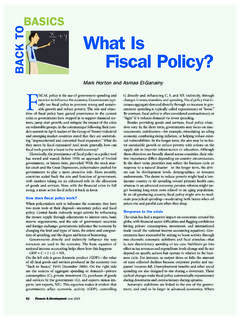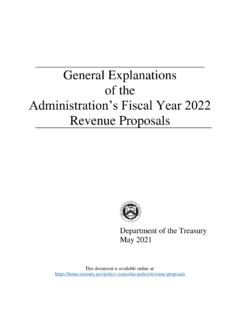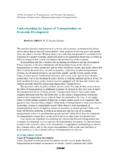Transcription of Effectiveness of Monetary and Fiscal Policy under IS/LM ...
1 Effectiveness of Monetary and Fiscal Policy under IS/LM Framework (Part 1) (NOTE THIS LECTURE IS COMPILED FROM INTERNET FOR TEACHING PURPOSE) The relative Effectiveness of Monetary and Fiscal Policy has been the subject of controversy among economists. The monetarists regard Monetary Policy more effective than Fiscal Policy for economic stabilisation. On the other hand, the Keynesians hold the opposite view. In between these two extreme views are the synthesists who advocate the middle path. Before we discuss them, we study the Effectiveness of Monetary and Fiscal Policy in terms of shape of the IS curve and the LM curve.
2 The IS curve represents Fiscal Policy and the LM curve Monetary Policy . SUBTOPICS: 1. Monetary Policy 2. Fiscal Policy 3. The Synthesist View: Three Range Analysis 3(a). Monetary Policy 3(b). Fiscal Policy 4. Monetary - Fiscal Mix First two are discussed in this lecture(part 1) .Next two in Part 2 1. Monetary Policy The government influences investment, employment, output and income through Monetary Policy . This is done by increasing or decreasing the money supply by the Monetary authority. When the money supply is increased, it is an expansionary Monetary Policy . This is shown by shifting the LM curve to the right.
3 When the money supply is decreased, it is a contractionary Monetary Policy . This is shown by shifting the LM curve to the left. Figure 1 illustrates an expansionary Monetary Policy with given LM and IS curves. Suppose the economy is in equilibrium at point E with OY income and OR interest rate. An increase in the money supply by the Monetary authority shifts the LM curve to the right to LM1given the IS curve. This reduces the interest rate from OR to OR1 thereby increasing investment and national income. Thus the national income rises from OY to OY1. But the relative Effectiveness of Monetary Policy depends on the shape of the LM curve and the IS curve.
4 Monetary Policy is more effective if the LM curve is steeper. A steeper LM curve means that the demand for money is less interest elastic. The less interest elastic is the demand for money, the larger is the fall in interest rate when the money supply is increased. This is because when the demand for money is less elastic to a change in interest rate, an increase in the money supply is more powerful in the bringing about a large fall in interest rate. A large fall in the interest rate leads to a higher increase in investment and in national income. This is depicted in Figure 2 where E is the original equilibrium position of the economy with OR interest rate and OY income.
5 When the steep LM1 curve shifts to the right to LMs, the new equilibrium is set at E2 .As a result, the interest rate falls from OR to OY2 and income rises from OY to OY2 .On the other hand, the flatter is the LM curve, the less effective is Monetary Policy . A flatter LM curve means that the demand for money is more interest elastic. The more interest elastic is the demand for money, the smaller is the fall in interest rate when the money supply is increased. A small fall in the interest rate leads to a smaller increase in investment and income. In Figure 2, E is the original equilibrium position with OR interest rate and OY income.
6 When the flatter LМ2curve shifts to the right to LMF the new equilibrium is established at E1 which produces OR1interest rate and OY1 income level. In this case, the fall in interest rate to OR1 is less than OR1 of the steeper LMs curve and the increase in income OY1 is also less than OY2 of the steeper curve. This shows that Monetary Policy is less effective in the case of the flatter LM curve and more effective in the case of the steeper curve. If the LM curve is horizontal, Monetary Policy is completely ineffective because the demand for money is perfectly interest elastic.
7 This is the case of liquidity trap shown in Figure 3, where the increase in the money supply has no effect on the interest rate OR and the income level OY. On the other hand, if the LM curve is vertical, Monetary Policy is highly effective because the demand for money is perfectly interest inelastic. Figure 4 shows that when the vertical LM curve shifts to the right to LM with the Increase in the money supply, the interest rate falls from OR to OR1which has no effect on the demand for money and the entire increase in the money supply has the effect of raising the income level from OY to OY1.
8 NOW take the slope of the IS curve. The patter is the IS curve, the more effective is the Monetary Policy . The flatter IS curve means that the investment expenditure is highly interest elastic. When an increase in the money supply lowers the interest rate even slightly, private investment also increases, by a large amount, thereby raising income much. This is depicted in Figure 5 where the original equilibrium is at point E with OR interest rate and OY income level. When the LM curve shifts to the right to LM1 with the increase in money supply, it intersects the flatter curve ISF at E2 which produces OR2 interest rate and OY2 income.
9 If we compare this equilibrium position Е2 with the E1position where the curve ISs is steeper, the interest rate OR1 and the income level OY1 are lower than the interest rate and income level of the flatter ISF curve. This shows that when the money supply is increased, a small fall in the rate of interest leads to a large rise in private investment which raises income more (by YY2) with the flatter ISf curve as compared to the steep IS curve (by YY1) thus making Monetary Policy more effective. If the IS curve is vertical Monetary Policy is completely ineffective because investment expenditure is completely interest inelastic.
10 With the increase in the money supply, the LM curve shifts to the right to LM1 in Figure 6, the interest rate falls from OR to OR1 but investment being completely interest inelastic, the income remains unchanged at OY. On the other hand, if the IS curve is horizontal, Monetary Policy is highly effective because investment expenditure is perfectly interest elastic. Figure 7 shows that with the increase in the money supply, the LM curve shifts to LM1 .But even with no change in the interest rate OR, there is a large change in income from OY to OY1 This makes Monetary Policy highly effective.








